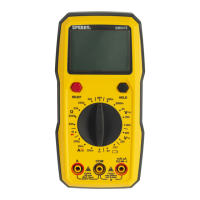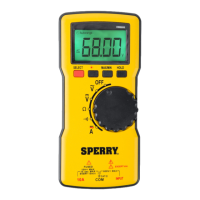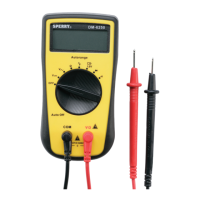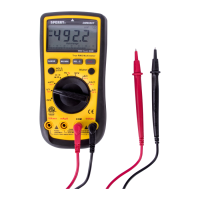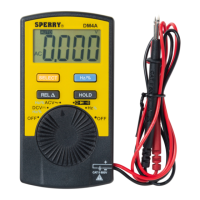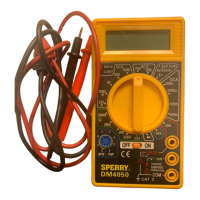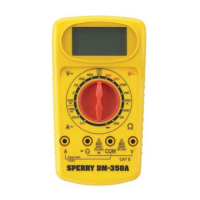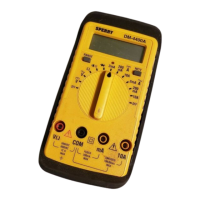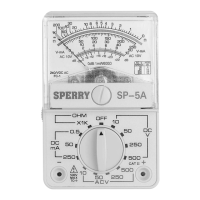2.2 OPERATING INSTRUCTIONS
1. Set the function/range switch to the proper position before making a measurement. When the voltage is not known, it MUST be determined that the capacity
of the selected range will handle the amount of voltage in the circuit (see #3 under “For Your Safety”).
2. Avoid placing the meter in areas where vibration, dust or dirt are present. Do not store the meter in excessively hot, humid or damp places.
This meter is a sensitive measuring device and should be treated with the same regard as other electrical and electronic devices.
3. When the meter is not in use keep the meter turned off to keep the battery from discharging.
4. When disconnecting the test leads from the unit, always grasp the leads where the input jacks meet the tester housing. Do not pull the leads out of the jacks
by the insulated wire or transport the tester using the test leads as a carrying strap.
5. Do not immerse the meter in water or solvents. To clean the housing use a damp cloth with a minimal amount of mild soap.
NOTE: With any measurement made by this meter, there will be some fluctuation of the digital display. This is due to the meter’s sampling method. This unit
samples at a rate of 2 times per second, thus the fluctuation of the readout.
3.0 FUNCTION BUTTONS
3.1 POWER BUTTON TURNS METER POWER ON AND OFF
1. To conserve battery life the meter powers off automatically after 15 minutes of non use.
To disable auto off press the select button while turning the meter on.
3.2 HOLD BUTTON
1. Press HOLD once to enter data hold mode to freeze the displayed value.
2. Press HOLD again to exit data hold mode and resume normal measurement mode.
4.0 DIAL SETTINGS
To avoid personal injury or damage to the Meter, do not attempt to measure voltages higher than 750V AC.
4.1 AC VOLTS V~
There are four ranges for measuring AC voltage, 2V, 20V, 200V, 750V. For more accurate measurements use the lowest setting possible without exceeding
the voltage setting. Ie. Use the 2V setting only if the voltage is 2 V or less.
1. Set the function/range switch to the appropriate AC V range.
2. Insert the black test lead into the COM input terminal.
3. Insert the red test lead into the V input terminal.
4. Touch the test leads to the circuit under test. With AC voltage, the polarity of the test leads is not a factor.
NOTE: It is best to touch one of the test leads to ground or Neutral first and then touch the 2nd test lead to the hot wire.
5. Read the value of the measurement displayed.
6. Typical AC Voltage measurements include wall outlets, appliance outlets, motors, light fixtures and switches.
4.2 DC VOLTS
To avoid personal injury or damage to the Meter, do not attempt to measure voltages higher than 1000V DC. There are five ranges for measuring DC
voltage, 200mV, 2V, 20V, 200V and 1000V. For more accurate measurements use the lowest range possible without exceeding the voltage setting.
1. Set the function/range switch to the appropriate DC V range.
2. Insert the black (negative) test lead into the COM input terminal.
3. Insert the red (positive) test lead into the V input terminal.
4. Touch the test leads to the circuit under test. With DC voltage, the polarity of the test leads is a factor. Touch the black (common) test lead to the negative
DC source (ground) first and red (positive) test lead to the “live” source second.
5. Read the value of the measurement displayed. If the leads are reversed a “-“ indicator will appear on the display.
6. Typical DC Voltage measurements include car batteries, automotive switches, motors and house hold batteries.
4.3 AC AMPS A~
Never attempt an in-circuit current measurement where the open circuit voltage between terminals and ground is greater than 30V AC. If the fuse
burns out during measurement, the meter may be damaged or personal injury may occur. Use proper terminals, function, and range for the measurement.
When the test leads are connected to the Amp terminals, DO NOT connect them in parallel across any circuit.
To avoid possible damage to the Meter or to the equipment under test, check the Meter’s fuses before measuring current. Use the proper terminals,
function, and range for the measurement. Never place the test leads in parallel with any circuit or component when the leads are plugged into the current
terminals.
Do not attempt to measure current exceeding 10Amps AC. If you are not sure if the current exceeds 10Amps do not attempt to measure current with
this meter.
1. Set the rotary switch to 10 Amps AC.
2. Insert the black test lead into the COM input terminal.
3. Insert the red test lead into the 10A max terminal.
4. Turn off power to the circuit to be measured.
5. Open the circuit to be measured.
6. Touch the red test lead to one side of the break in circuit and the black test lead to the other side of the break in circuit. For AC Amp measurement the
polarity of the leads does not matter.
7. Return power to the circuit.
8. Read the amps on the display.
Notes: When measuring AC Amps this meter displays the effective value of the sine wave (mean value response). When the measured current is <5 amps
continuous measurement is acceptable.
When the measured current is 5–10 amps do not exceed 10 seconds of continuous measurement. Wait 15 minutes before performing additional
current measurements.
Always start with the highest 10A~ measurement range and reduce the range in steps once you know that the current does not exceed the next lower range.
The red test lead will be inserted into the µA mA input terminal for measuring amps 200m Amps. Always turn of power to circuit and remove the leads from the
circuit before removing and reinserting the leads into the meter’s input terminals. Once the measurement is complete, immediately remove the test leads from
the circuit under test and remove the test leads from the input terminals of the meter.
4
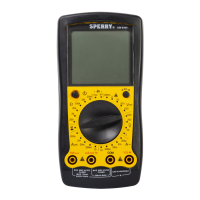
